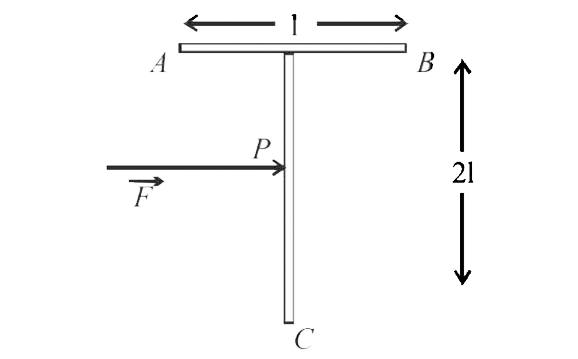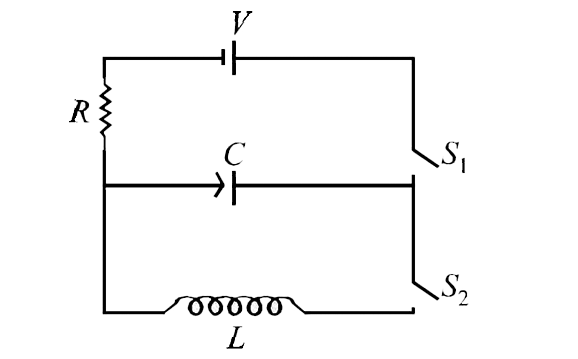Two discs A and B are mounted coaxially ona vertical axle. The discs have moments of inertia l and 2l respectively about the common axis. Disc A is imparted an initial angular velocity 2ω using the centre potential energy of a spring compressed by a distance x1. Disc B is imparted angular velocity ω by a spring having the same spring constant and compressed by a distance x2. Both the disc rotate in the clockwise direction.
When disc B is brought in contact with disc A, they acquirea common angularvelocity in time t. The average frictional torque on one disc by the other during this period is -
2Iω(3t)
9Iω/(2t)
9Iω/(4t)
3Iω/(2t)
The correct Answer is:A
Step by step video, text & image solution for Two discs A and B are mounted coaxially ona vertical axle. The discs have moments of inertia l and 2l respectively about the common axis. Disc A is imparted an initial angular velocity 2 omega using the centre potential energy of a spring compressed by a distance x_(1). Disc B is imparted angular velocity omega by a spring having the same spring constant and compressed by a distance x_(2). Both the disc rotate in the clockwise direction. When disc B is brought in contact with disc A, they acquirea common angularvelocity in time t. The average frictional torque on one disc by the other during this period is - by Physics experts to help you in doubts & scoring excellent marks in Class 12 exams.
Updated on:21/07/2023Topper's Solved these Questions
Similar Questions
A 'T' shaped object with dimensions shown in the figure, is lying on a smooth floor. A force '→F' is applied at the point P parallel to AB, such that the object has only the translational motion without rotation. Find the location of P with respect C.

View SolutionIn the given circuit the capacitor (C) may be charged through resistance R by a battery V by closing switch (S1). Also when (S1) is opend and (S2) is closed the capacitor is connected in series with inductor (L).

At the start, the capicitor was uncharged. when switch (S1) is closed and (S2) is kept open, the time constant of this circuit is τ. which of the following is correct
View SolutionTwo discs A and B are mounted coaxiallay on a vertical axle. The discs have moments of inertia I and 2 I respectively about the common axis. Disc A is imparted an initial angular velocity 2 omega using the entire potential energy of a spring compressed by a distance x_1 Disc B is imparted an angular velocity omega by a spring having the same spring constant and compressed by a distance x_2 Both the discs rotate in the clockwise direction. The ratio x_1//x_2 is
View SolutionTwo discs A and B are mounted coaxiallay on a vertical axle. The discs have moments of inertia I and 2 I respectively about the common axis. Disc A is imparted an initial angular velocity 2ω using the entire potential energy of a spring compressed by a distance x1 Disc B is imparted an angular velocity ω by a spring having the same spring constant and compressed by a distance x2 Both the discs rotate in the clockwise direction.
When disc B is brought in contact with disc A, they acquire a common angular velocity in time t. The average frictional torque on one disc by the other during this period is
View SolutionTwo discs A and B are mounted coaxiallay on a vertical axle. The discs have moments of inertia I and 2 I respectively about the common axis. Disc A is imparted an initial angular velocity 2 omega using the entire potential energy of a spring compressed by a distance x_1 Disc B is imparted an angular velocity omega by a spring having the same spring constant and compressed by a distance x_2 Both the discs rotate in the clockwise direction. The loss of kinetic energy in the above process is
View SolutionTwo discs A and B are mounted coaxially ona vertical axle. The discs have moments of inertia l and 2l respectively about the common axis. Disc A is imparted an initial angular velocity 2ω using the centre potential energy of a spring compressed by a distance x1. Disc B is imparted angular velocity ω by a spring having the same spring constant and compressed by a distance x2. Both the disc rotate in the clockwise direction.
The rotation x1/(x2 is.
View SolutionTwo discs A and B are mounted coaxially ona vertical axle. The discs have moments of inertia l and 2l respectively about the common axis. Disc A is imparted an initial angular velocity 2 omega using the centre potential energy of a spring compressed by a distance x_(1) . Disc B is imparted angular velocity omega by a spring having the same spring constant and compressed by a distance x_(2) . Both the disc rotate in the clockwise direction. When disc B is brought in contact with disc A , they acquirea common angularvelocity in time t . The average frictional torque on one disc by the other during this period is -
View SolutionTwo discs A and B are mounted coaxially ona vertical axle. The discs have moments of inertia l and 2l respectively about the common axis. Disc A is imparted an initial angular velocity 2 omega using the centre potential energy of a spring compressed by a distance x_(1) . Disc B is imparted angular velocity omega by a spring having the same spring constant and compressed by a distance x_(2) . Both the disc rotate in the clockwise direction. The loss of kinetic energy the above process is -
View SolutionTwo discs A and B are mounted coaxially on a vertical axle. The discs have moments of inertia I and 2I respectively about the common axis. Disc A is imparted an initial angular velocity 2ω using the entire potential energy of a spring compressed by a distance x1. Disc B is imparted an angular velocity ω by a spring having the same spring constant and compressed by a distance x2. Both the discs rotate in the clockwise direction.
A small object of uniform density rolls up a curved surface with an initial velocitiy v. It reaches upto a maximum height of 3v24g with respect to the initial position. The object is:
View Solutionदो डिस्कें A तथा B एक ऊर्ध्वाधर धुरी पर समाक्ष रूप से अवस्थिरत की गई है। उभयनिष्ठ अक्ष के परितः उन चकतियों के जड़त्व आघूर्ण क्रमशः I तथा 2I है। एक स्पि्रंग को x1 दूरी से दबाकर उसकी सम्पूर्ण स्थितिज ऊर्जा का उपयोग करके, चकती A को प्रारंभिक कोणीय वेग 2ω दिया जाता है। उतने ही स्पि्रंग गुणांक वाले एक दूसरे स्पि्रंग को x2 दूरी से दबाकर डिस्क B को कोणीय वेग ω दिया जाता है। दोनों चकतियां दक्षिणावर्त दिशा में घूम रही हैं
जब डिस्क B को डिस्क A के साथ सम्पर्क में लाया जाता है तो वे t समय में समान कोणीय वेग प्राप्त कर लेती है। इस अवधि में एक डिस्क पर दूसरी के द्वारा लगाया गया औसत घर्षण बल-आघूर्ण है।
View SolutionTwo discs A and B are mounted co-axially on a vertical axie. The discs have moments of inertia I and 2I , respectively, about the common axis. Disc A is imparted an initial angular velocity 2 omega using the entire potential energy of a spring compressed by a distance x_(1) . Disc B is imparted an angular velocity omega by a spring having the same spring constant and compressed by a distance x_(2) . Both the discs rotate in the clockwise direction. The ratio (x_(1))/(x_(2)) is
View SolutionTwo discs A and B are mounted co-axially on a vertical axie. The discs have moments of inertia I and 2I , respectively, about the common axis. Disc A is imparted an initial angular velocity 2 omega using the entire potential energy of a spring compressed by a distance x_(1) . Disc B is imparted an angular velocity omega by a spring having the same spring constant and compressed by a distance x_(2) . Both the discs rotate in the clockwise direction. When disc B is brought in contact with disc A, they acquire a common angular velocity in time t. The average frictional torque on one disc by the other during this period is
View SolutionTwo discs A and B are mounted co-axially on a vertical axie. The discs have moments of inertia I and 2I , respectively, about the common axis. Disc A is imparted an initial angular velocity 2ω using the entire potential energy of a spring compressed by a distance x1. Disc B is imparted an angular velocity ω by a spring having the same spring constant and compressed by a distance x2. Both the discs rotate in the clockwise direction.
The loss of kinetic energy during the above process is
View SolutionTwo discs A and B are mounted coaxially on a vertical axle. The discs have moments of inertia I and 2I respectively about the common axis. Disc A is imparted an initial angular velocity 2omega using the entire potential energy of a spring compressed by a distance x_(1) . Disc B is imparted an angular velocity omega by a spring having the same spring constant and compressed by a distance x_(2) . Both teh discs rotate in the clockwise direction. The ratio (x_(1))/(x_(2)) is :
View SolutionParagraph-1 : Two discs A and B are mounted coaxially on a vertical axle. The discs have moments of inertia I and 2I respectively about the common axis. Disc A is imparted an initial angular velocity 2omega using the entire potential energy of a spring compressed by a distance x_(1) . Disc B is imparted an angular velocity omega by a spring having the same spring constant and compressed by a distance x_(2) . Both the discs rotate in the clockwise direction. The ratio x_(1)//x_(2) is :
View SolutionParagraph-1 : Two discs A and B are mounted coaxially on a vertical axle. The discs have moments of inertia I and 2I respectively about the common axis. Disc A is imparted an initial angular velocity 2omega using the entire potential energy of a spring compressed by a distance x_(1) . Disc B is imparted an angular velocity omega by a spring having the same spring constant and compressed by a distance x_(2) . Both the discs rotate in the clockwise direction. When disc B is brought in contact with disc A, they acquire a common angular velocity in time t. The average frictional torque on one disc by the other during this period is :
View Solution